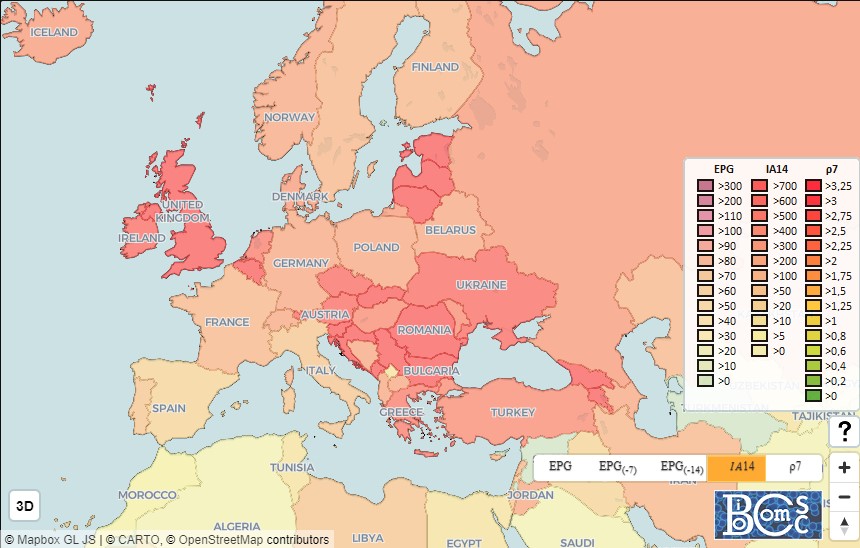Catalonia's Covid incidence rate grows, but far milder than European average
Three quarters of Catalans fully vaccinated, among highest rates on continent

Catalonia's Covid-19 incidence rate is steadily growing again, surging from 50 cases per 100,000 inhabitants in the last 14 days at the end of October to 65.48 as of November 9.
The long decrease in transmissions after the fifth Covid wave in summer came to a halt on October 21, hitting a low at 45.27 cases.
Yet, the surge of the pandemic in Catalonia is far milder than that in the vast majority of European countries, according to November 8 figures from a working group in Catalonia’s Polytechnic University (UPC), BIOCOMSC.
Catalonia's incidence rate is 65, with some countries surpassing 1,000
The attack rate in the past 14 days per 100,000 inhabitants exceeds 1,000 in Estonia (1,738), Slovenia (1,695), Latvia (1,603), Lithuania (1,427), Croatia (1,318), and Slovakia (1,139).
Most countries in Europe oscillate between an incidence rate of 200 and 1,000, including Austria (907), the United Kingdom (791), Ireland (765), the Netherlands (662), Hungary (500), Germany (359), and Norway (292).
Countries such as France (130), Portugal (117) and Sweden (101) have the pandemic also under control, but not as much as Spain (43). Check the BIOCOMSC map here.
However, authorities in Catalonia have been warning of an increase in the pandemic figures for weeks. Indeed, two outbreaks in the past few days, in Brians-2 jail affecting 100 people and in a Sant Cugat del Vallès school with 347 people in self-isolation, have been revealed in the past few days.
Yet, the ease of restrictions that began in October continues and the Catalan government has not hinted at any tightening. Check out this Catalan News podcast published on October 17 on the loosened measures:
Sharp rise in transmission rate
Not only is the incidence rate growing, but also the outbreak risk, which is calculated using an iEPG index found by multiplying the average spread of the virus over the past seven days by the cumulative incidence over the past two weeks. This indicator has been slightly growing since mid-October, when it hit its low at 37, to 85 on November 9 – the outbreak risk is still considered 'moderate,' but approaching 'high', at 100 or over.
Likewise, the transmission rate, the average number of times somebody positive with Covid-19 will transmit the virus to another person, is also going up. In mid-October it surpassed 1 and on November 9 it surged 0.18 points in a single day to 1.36.
Yet, hospitals have not noticed this surge in cases yet – patients in hospital beds due to Covid-19 have been oscillating between 300 and 350 for a month, with 78 of them in ICUs, the all-time low during the health emergency since July 29, 2020, the first day with figures.
The mild impact of the pandemic compared to other neighboring countries may be explained due to the high rates of vaccination.
High vaccination rates generally synonym of milder pandemic situation
As of November 9, 2021, 5,995,905 residents have been given the first dose of the vaccine, 75.8% of the total population, and 74.5% are considered to be fully immunized.
These figures are significantly higher than the EU/EEA average, at 69.4% of people with at least a dose and 64.8% fully vaccinated, according to European Centre for Disease Prevention and Control figures of November 10.
The same source shows that the vast majority of European countries is behind Catalonia in vaccinations, with Italy (72.1%), France (68.7%), Sweden (67.2%), Germany (66.7%) and the Netherlands (64.7%) some points behind.
Yet, others have significantly lower vaccination rates, including Austria (63.3%), Hungary (58.5%), Czech Republic (57.4%), Estonia (56.6%), Poland (53%), Croatia (45%), Slovakia (44.8%) and Bulgaria (22.6%).
Portugal (81%) is top of the rankings, as the countries with high rates of vaccinations generally match with those facing milder growths of the pandemic, with Ireland among the few exceptions (75.7% of rollout).